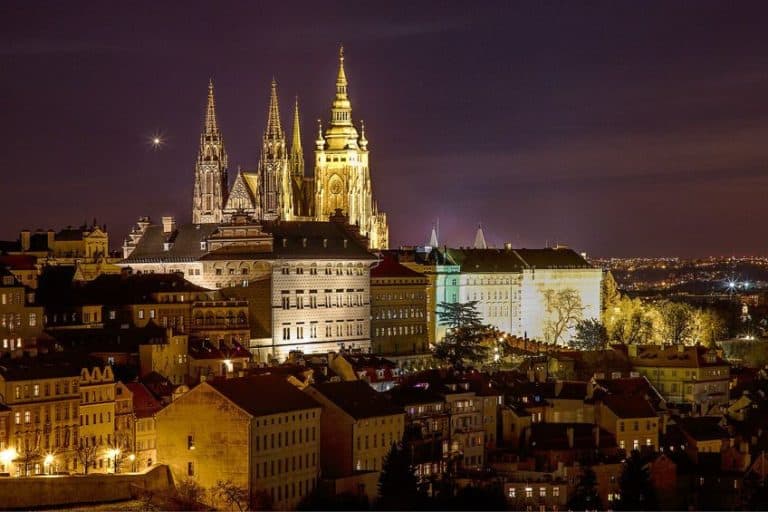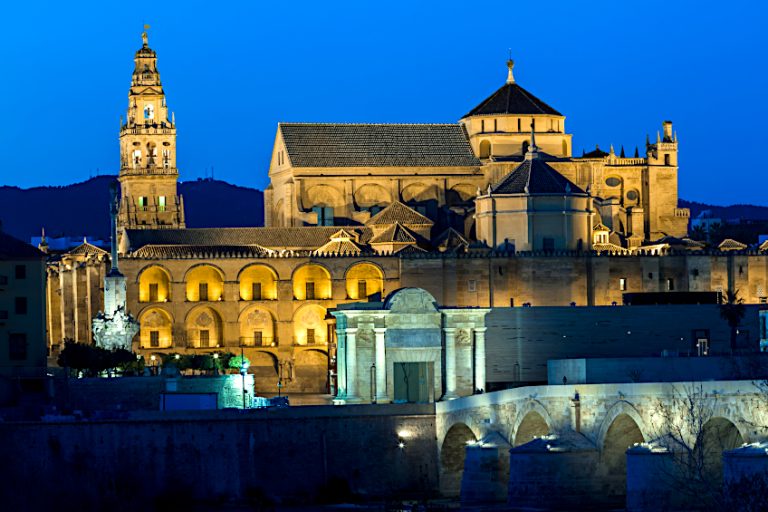Temple of Dendur – Explore the Historical Egyptian Temple
The Temple of Dendur is a Roman Egyptian temple edifice located about 80 kilometers south of modern Aswan in Tuzis, Nubia. Emperor Augustus ordered the construction of a temple that was to be dedicated to Isis, the Egyptian Goddess, and the Nubian deified brothers Pihor and Pedesi in 23 BCE. If you want to know where to find the Egyptian Temple of Dendur, then look no further, this article will explore all there is to know about this iconic temple.
The Egyptian Temple of Dendur
| Architect/ Patron | Emperor Augustus (63 BCE – 14 CE) |
| Date Completed | 10 BCE |
| Function | Egyptian temple |
| Location | Metropolitan Museum of Art, New York City, United States |
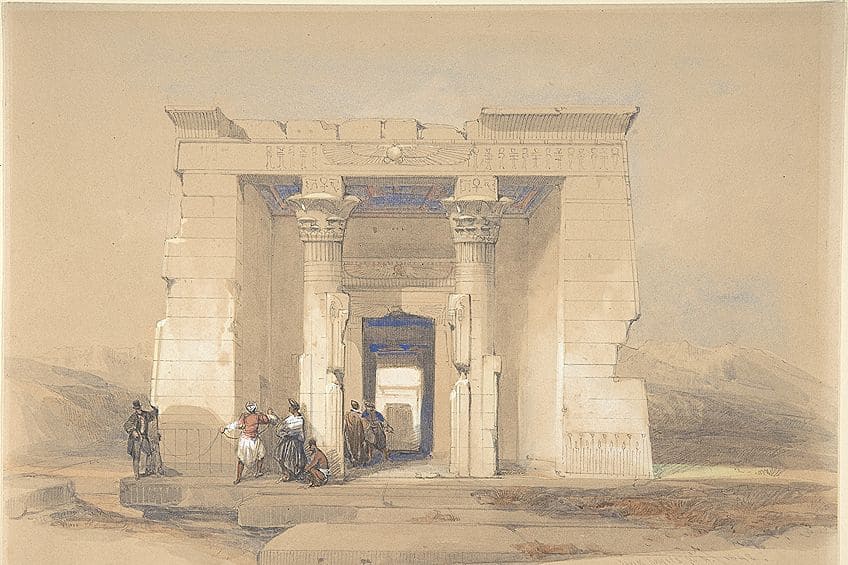
As part of the global initiative to preserve Nubia’s monuments, UNESCO assisted in the preservation and relocation of the temple from inundation induced by the Aswan High Dam in 1963. Egypt donated the monument to New York’s Metropolitan Museum of Art, where it has been on display since 1978. Let’s take a look at the Egyptian Temple of Dendur’s history.
History of the Dendur Temple
The Temple of Dendur was erected at the behest of Caesar Augustus, the Roman emperor who ruled Egypt at the time, by Petronius, the Roman administrator of Egypt. Augustus, formerly called Octavian, became Ruler in 31 BCE after conquering Mark Antony and Egyptian Queen Cleopatra. Augustus had Egyptian-style shrines erected and consecrated to Egyptian goddesses and gods throughout his reign. Nevertheless, he only built a few monuments in Nubia.
One of these was the Temple of Dendur, which he built in Tuzis on the Nile’s Western bank. Construction began in 23 BCE and was completed in 10 BCE.
The temple was utilized by Augustus to exemplify and preserve his authority. His method included associating his image and name with Isis, the major deity at Dendur, as well as the local cults of Pihor and Pedesi. It was so much more than just a temple; it was also a residence for the gods. When the locals attended the shrine and gave traditional offerings of wine, incense, cool water, clothes, milk, and food, they not only nourished their emperor, Augustus but also insured the prosperity of their town. Coptic Christians utilized the place as a church in the 6th century.
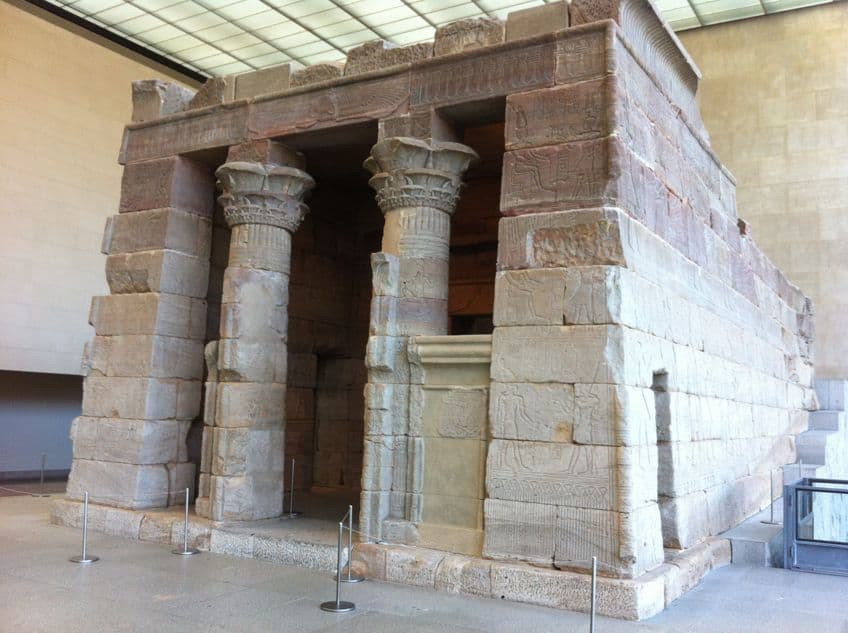
The temple’s closeness to the Nile was a concern when Egypt raised the elevation of the Aswan Low Dam in 1933. The building began to flood for nine months every year.
Relocation
Egypt began construction on the Aswan High Dam in 1960. Lake Nasser was supposed to permanently submerge the temple. UNESCO launched the International Campaign to Save Nubia’s Monuments, which included the Temple of Dendur. 50 countries contributed equipment, knowledge, and money to the initiative. For two years, Egyptologists, photographers, and architects recorded and analyzed the temple. In 1963, the temple was moved from its original location after being dismantled.
Egypt gave the monument to the United States in 1965 in gratitude for the $16 million donation toward the preservation of numerous ancient antiquities jeopardized by the dam’s construction.
On behalf of the U.S., Jacqueline Kennedy acknowledged the present. The National Foundation for the Arts and Humanities established a commission in 1967 to review proposals from organizations interested in displaying the Egyptian temple. Since their city’s namesake was in Egypt, museums in Illinois, Cairo, and Memphis, Tennessee believed they were the appropriate choice.
The commission was not convinced though. The Smithsonian Institution suggested building the structure on the Potomac River in Washington, D.C., whereas the Charles River was favored by the Bostom Museum of Fine Arts. The committee, however, rejected these recommendations since the temple’s stone would deteriorate in an outside setting. President Lyndon B. Johnson presented the Egyptian Temple of Dendur to The Metropolitan Museum of Art on the 20th of April 1967. The Met was chosen by the commission because it had a clear strategy for locating and protecting the structure from weather, contaminants, and the various environments in the United States.
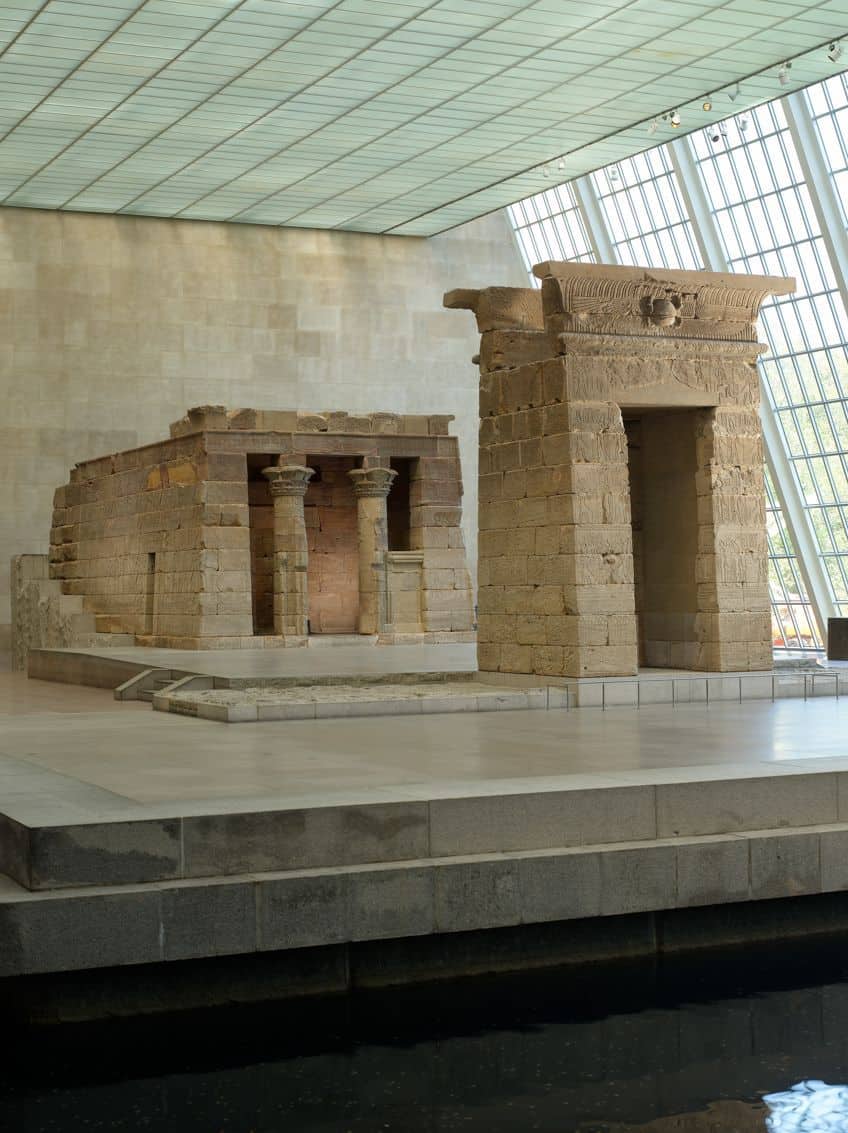
The Met intended to house the temple inside a facility that would recreate Egypt’s high temperatures and dry conditions, which had maintained the edifice for generations. The temple and its associated pylon were made out of around 660 sandstone pieces totaling 580,000 kg. The blocks were stacked in roughly 660 containers and delivered to America by the vessel SS Concordia Star six years after they were demolished. On the 29th of August 1968, the dismantled temple landed in New York City. The temple’s relocation cost $9.5 million. Lila Acheson Wallace provided financial support for the Egyptian temple’s transfer and resettlement in the museum.
The museum erected a new wing to accommodate the monument. The museum’s new wing was created by architects John Dinkeloo and Kevin Roche. Roche was an admirer of Egyptian architecture and had already included pyramids in his architectural projects. The builders put a water feature in front of the monument and a sloping wall behind it to symbolize the Nile and the rocks of the original location; the temple preserved its historic orientation toward the east. They also created a glass-stippled ceiling and northern wall to absorb light and emulate Nubia’s illumination. They utilized a room and technology to reproduce Egypt’s climate.
On the 15th of July 1975, stonemasons and conservators from the museum began rebuilding the temple. On the 27th of September 1978, the public was able to view the temple display.
Six more Egyptian art galleries are located near the Temple of Dendur’s entryway. , “Architect Kevin Roche has built a showcase as effective in what it aims to achieve as the little shrine itself”, one art reviewer said. The museum named the wing that houses the shrine after the Sacklers. Because of the Sackler family’s involvement with the opioid problem, the museum ceased accepting gifts from them in 2019. The museum also opted to change the wing’s name.
Architecture
The Temple of Dendur is a simple Roman period structure having origins in previous Egyptian architectural styles. It, like the other structures in the area, was designed by indigenous Egyptian architects and built of pink-hued Nubian sandstone blocks. These people would have collaborated with Augustus’ workers to create the inscriptions and sculptures on the temple. The temple’s stone craftsmen and builders utilized millennia-old Egyptian structural esthetics and procedures. The Temple of Dendur complex was built on a sandstone platform or terrace 30 meters above the Nile.

A mud brick wall encircled the temple compound, measuring 25 meters from the front gate to the back gate and standing 8 meters tall. The wall, which is now gone, used to limit entry to the temple compound. The Nile’s entryway was a massive pylon that still stands today. This gate was known as the “Luminous Mountain Horizon” by the Egyptians. The pylon is adorned with relief carvings, has curved tori at the tops and corners of its sides, and is topped with a cavetto cornice, a popular architectural feature in Egyptian architecture. A processional path, or dromas, led 9 meters from the pylon to the temple structure across an open court.
The temple is divided into three parts: the antechamber, the pronaos, and the sanctuary. The porch is the temple’s entrance.
It has two ornate columns that feature composite tops showing lotus blooms, a style popular in the Egyptian culture between 664 and 525 BCE. The antechamber, originally divided by wooden doors, enters into the sanctuary, where the ancient Egyptians thought the gods lived. Inside the sanctuary area, there was a holy bark repository stone and a statue niche. The sanctuary’s rear wall has a concealed room that may be accessible by rotating a stone block on the sanctuary’s outer southern wall, but its use is unknown. A little room was built into the rock face on the mountainsides behind the temple. It might have been the location of Pihor and Pedisi’s grave or a replica of their tomb.
Ornamental Decorations
The temple is adorned with relief sculptures that were previously painted in vibrant hues. Augustus is represented as a pharaoh engaging with deities and gods. Arsenuphis, Amum of Debod, Hathor of Bigga, Harpocrates, Isis, Horus, Osiris, Khnum, Mandulis, Nephthys, Satis, Harpocrates, Tephenis, and Thoth are among those holy entities. The decorations on the temple’s foundation depict lotus plants and papyrus emerging out of the Nile, representing the deity Hapi. The Winged Sun disk of the sky deity Horus, depicting the sky, is located above the pylon and over the entryway to the temple proper.

The sky theme is repeated by the vultures on the pronaos ceiling. Excluding the reliefs on the antechamber door frames and the sanctuary’s rear walls, neither the antechamber nor the sanctuary is adorned. The latter depicts Pedesi and Pihor as young gods who are respectively adoring Osiris and Isis. Sunk relief sculptures on the temple’s outside walls depict Emperor Augustus as a pharaoh bringing sacrifices to the goddesses Isis, Osiris, and their son Horus.
The motif is repeated in raised relief sculptures in the temple’s first chamber, depicting Augustus as he prays and gives sacrifices.
The engravings’ hieroglyphs allude to Augustus as Pharaoh, Caesar, and Autotrator. The latter is a variant of an autocrat, which is the Greek counterpart of imperator. This typo appears to be intentional in order to establish better symmetry in the hieroglyphs. The external south entryway is adorned with cobras wearing Egyptian crowns from lower and upper Egypt. A white crown represents upper Egypt, while a crimson crown represents lower Egypt. On the left side, Isis is depicted standing and sporting a close-fitting sheath, a cow horn headdress, and a winged disk denoting the sun deity.
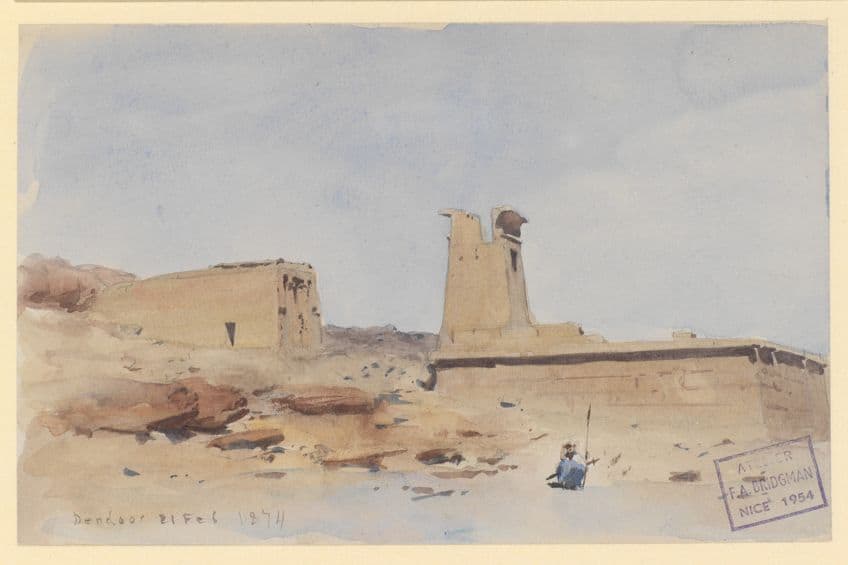
She carries an ankh, a sign of life, in one hand. The picture on the pronaos’ inner south wall represents the pharaoh and his two brothers receiving gifts of water and incense. The Egyptians thought that by offering incense to the gods, the pharaoh or Augustus may live eternally. The brothers were both seated and clutching a scepter, a sign of leadership and of life, in one hand. Isis is shown on the pronaos north wall. The pronaos columns are adorned with sunk reliefs representing men delivering animal and floral gifts to the temple.
Initially, the Temple of Dendur stood on the Nile’s left bank, close to the ancient village of Tutzis. The temple in Nubia was originally erected on a large stone platform overlooking the Nile. We know it was first seen and reported by early travelers. It bears the same notoriety as a handful of other Nubian temples, such as Abu Simbel, in that it was spared from the rising waters of Lake Nasser behind the High Dam by being demolished and relocated.
Frequently Asked Questions
How Do I Know Where to Find the Egyptian Temple of Dendur?
Whereas other Nubian monuments were merely relocated to higher land, the Temple of Dendur traveled all the way to the United States. It was handed to the United States by the Egyptian state in appreciation for its assistance in saving the other Nubian structures that would have been submerged underneath the waters of Lake Nasser. The temple’s 642 blocks, totaling more than 800 tons in weight, with the heaviest stones weighing more than 6.5 tons, were brought to the United States for roughly 9.5 million dollars.
Is There Graffiti on the Temple of Dendur?
Tourists to the temple scrawled graffiti on the edifice when it was beside the Nile. A tourist inscribed a vow on the Pronaos’ northern wall near the picture of Pihor as early as 10 BCE. There were also European tourists that scrawled graffiti on the walls of the temple in the 19th century. A significant dedication on the left side of the temple was carved by a naval officer from England, Lowry Corry. Girolamo Segato, an Italian Egyptologist, also left a graffiti message. When the structure was later utilized as a church in the 6th century, it sustained some damage. Presbyter Abraham carved on the walls to commemorate the building’s conversion to a Christian church.
Justin van Huyssteen is a freelance writer, novelist, and academic originally from Cape Town, South Africa. At present, he has a bachelor’s degree in English and literary theory and an honor’s degree in literary theory. He is currently working towards his master’s degree in literary theory with a focus on animal studies, critical theory, and semiotics within literature. As a novelist and freelancer, he often writes under the pen name L.C. Lupus.
Justin’s preferred literary movements include modern and postmodern literature with literary fiction and genre fiction like sci-fi, post-apocalyptic, and horror being of particular interest. His academia extends to his interest in prose and narratology. He enjoys analyzing a variety of mediums through a literary lens, such as graphic novels, film, and video games.
Justin is working for artincontext.org as an author and content writer since 2022. He is responsible for all blog posts about architecture, literature and poetry.
Learn more about Justin van Huyssteen and the Art in Context Team.
Cite this Article
Justin, van Huyssteen, “Temple of Dendur – Explore the Historical Egyptian Temple.” Art in Context. March 7, 2023. URL: https://artincontext.org/temple-of-dendur/
van Huyssteen, J. (2023, 7 March). Temple of Dendur – Explore the Historical Egyptian Temple. Art in Context. https://artincontext.org/temple-of-dendur/
van Huyssteen, Justin. “Temple of Dendur – Explore the Historical Egyptian Temple.” Art in Context, March 7, 2023. https://artincontext.org/temple-of-dendur/.



